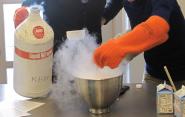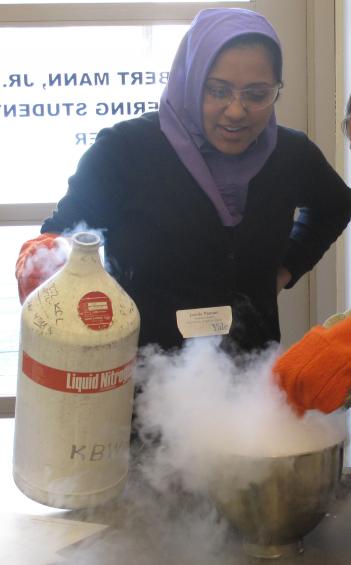Inspiring the Next Generation of Engineers

As lunch ended, the students gathered together to make “instant” ice cream out of just three ingredients: cream, sugar, and liquid nitrogen. It’s exciting—and to the shock of some, it’s engineering.

Such excitement (and shock) is the desired outcome of the Pathways to Science program hosting yesterday’s visit from these 40 students, who all attend local middle schools. Designed to support promising young scholars and encourage them to pursue careers in the sciences, the program serves up mini-experiments and lab tours that connect participants with actual Yale scientists.
Namratha Vedire, an electrical engineering doctoral candidate and one of yesterday’s “actual scientists,” showed each group of students the ins-and-outs of a speech recognition program. “The idea was to teach them how the program scans, what frequencies make up our voice, and how differently the computer thinks of a sound. They would speak, and the computer would display what it thought the sound actually was. In some cases it matched up, in some cases not,” said Vedire. “Some went the extra mile, generating speech using the sounds and the frequencies for the phone, and they were like this ‘This sounds exactly like Siri!’”
Graduate students from all four Yale engineering departments participated in the event, highlighting similar connections between their work and everyday experiences. They offered demonstrations of electromagnetic engines, catalytic reactions with soap bubbles, disassembled laptops, and how polymer water filers get created. Biomedical engineering doctoral candidate Jonas Schwan even demonstrated his work on growing muscle tissue that actually pulses on its own, which could be used in heart transplants.
“We can grow this artificial heart tissue using the patient’s own stem cells,” said Schwan, “so I can take my blood and derive stem cells out of it, then grow the same tissue that’s in my heart right now. And it’s so awesome to share this process because the kids had some fantastic questions, especially thinking about applications—a few of the seventh graders have a tremendous knowledge of cell biology.”
After a morning of such demonstrations, the Pathways participants broke for lunch and the instant ice cream before they dug into an intergroup engineering competition: building a one-foot-high structure capable of a) supporting as much weight as possible and b) looking as artistic as possible. The kicker? The entire structure had to made with only newspaper.
That kind of challenge is exactly what Vedire likes about the Pathways to Science program, noting that it helps students understand how engineers, using both science and creativity, approach real-world problems. And while students may have classes in physics and biology, most high schools don’t offer engineering classes. “I feel there’s not enough exposure for the field, so people aren’t sure what engineering is,” says Vedire. “Demos like this give insight into what engineers from all areas do. And to do to offer that experience in just a three hour span, that’s amazing.”
Visit the Yale Pathways to Science homepage for more information or to view upcoming Pathways events: yale.edu/scienceoutreach

